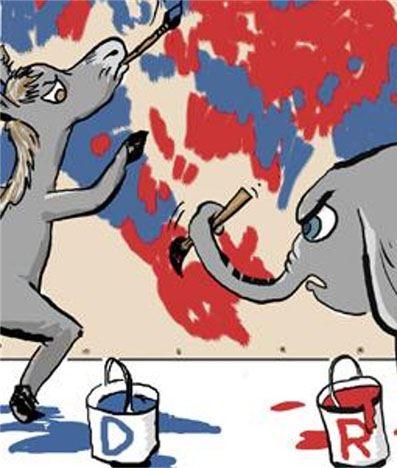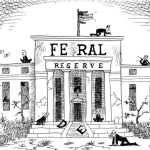In recent years, Congress has passed very few pieces of significant legislation. This is because the Democratic and Republicans parties have little ideological overlap. Congress’s approval rating is at an all-time low, but paradoxically, Congressional incumbents have an eighty percent likelihood of being reelected. A major cause of the polarization of the political parties and political gridlock is the result of gerrymandering. Gerrymandering is the process by which electoral districts are drawn to favor one political party or racial group. Although this strategy has existed since the early nineteenth century, it has been used more frequently in recent decades to protect incumbents and guarantee which party will win congressional general elections. The vendetta is how to end any system that allows redistricting to influence who is elected as a representative, while still maintaining our democracy.
The Constitution dictates that each state gets a certain number of districts, based on population, and state legislatures and other elected representatives determine how those districts are drawn. Each district in a state is supposed to have approximately the same number of constituents. Gerrymandering refers to drawing the districts to give a certain racial group or political party a majority, ensuring that a representative of that race or party is elected.
Racial gerrymandering was originally done to dilute the minority vote. The Voting Rights Act of 1965 said that this practice is illegal. It is now done to ensure that minorities are able to elect a representative that will pursue their interests. That representative is often of the racial background of his or her constituents. The Supreme Court ruled that affirmative racial gerrymandering was constitutional in 1993. Critics of racial gerrymandering say that it allows representatives to say they are representing the district’s majority racial group, instead of all of their constituents. However, most would acknowledge that racial gerrymandering allows for a greater number of minorities in elected government, strengthening representation and trust in government. Gerrymandering to promote a minority group is less controversial than when it is done to promote a political party.
The United States is alone in allowing self-interested politicians to govern the redistricting process. Partisan gerrymandering started in 1812, when Governor Gerry of Massachusetts created a district to help the Democratic-Republicans. When a political party redistricts a state, it wants to concentrate the opposition party into a few districts, while maintaining as many districts for itself as possible. It is also likely to crack districts, which means it wants to spread its supporters into as many districts as possible, as long as they are able to maintain majorities. The result is that there is little competition in general elections, while primaries become more significant. Republicans are forced to run to the right to fend off more conservative challengers, while Democrats run to the left. As a result, there is little ideological overlap between elected representatives. The majority of Americans, moderate in ideology, are poorly represented.
The GOP landslide in the 2010 midterm election gave “Republican state legislatures around the country unprecedented power to redraw political boundaries.” [ref]Thomas Friedman, “Our Democracy Is at Stake,” The New York Times, Oct. 1, 2013.[/ref] Despite the fact that fifty percent of South Carolinians voted Democratic in Congressional elections, and forty-eight percent voted Republican in 2012, South Carolina elected nine Republicans and five Democrats to the House of Representatives.[ref]”What Is Gerrymandering?” YouTube, May 11, 2015.[/ref] This failure of America’s system of representative government hurts voters’ confidence in the democratic process.[ref]Christopher Ingraham, “One Easy Way to End Gerrymandering: Stop Letting Politicians Draw Their Own Districts,” Washington Post, June 2, 2014.[/ref]
The easiest solution to this problem would be for the Supreme Court to rule that the current manner of redistricting is unconstitutional. This seems unlikely since the justices are unable to make a decision on this issue. In 1986 and 2004, the Supreme Court ruled that problem is unsolvable, even though partisan gerrymandering may violate Equal Protection Clause of the Fourteenth Amendment and the 1965 Voting Rights Act, which protects the principle of “one person, one vote.”[ref]”What Is Gerrymandering?” YouTube, May 11, 2015.[/ref] Instead, the Court assumes that “to the victor goes the spoils” and does little to stop the process. It has ruled, however, that certain redistricting plans violate the Equal Protection Clause and the Voting Rights Act. In those instances, the Court said that a federal court must order the jurisdiction to propose a new redistricting plan that remedies the gerrymandering.
Another potential solution is to take district drawing away from politicians. California, Arizona, Washington, and Idaho have already set up independent commissions to handle their redistricting. Congressman Alan Lowethal from California, introduced the “Let the People Draw the Lines Act” to the House of Representatives in 2013. If passed, it will create similar independent redistricting commissions for the other states. The California panel consists of five Democrats, five Republicans, and four Independents. No one in the group can have run for office or have economic ties to either party. However, most people tracking this legislation are pessimistic. The California bill that is the basis for this bill took seven years to pass. The federal bill is expected to face even greater opposition. It would require a lot of pressure from everyday Americans, the media, and the President to convince elected officials to vote for something that lessens their power and job safety.[ref]Christopher Ingraham, “One Easy Way to End Gerrymandering: Stop Letting Politicians Draw Their Own Districts,” Washington Post, June 2, 2014.[/ref] Until this issue is reformed, voters do not choose their representatives. Representatives choose their voters.
Take Action:
Sign this petition to end gerrymandering!




